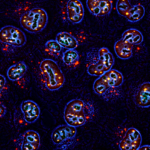Lien vers Pubmed [PMID] – 7638205
Proc. Natl. Acad. Sci. U.S.A. 1995 Aug;92(16):7401-5
The t(15;17) chromosomal translocation, specific for acute promyelocytic leukemia (APL), fuses the PML gene to the retinoic acid receptor alpha (RAR alpha) gene, resulting in expression of a PML-RAR alpha hybrid protein. In this report, we analyzed the nature of PML-RAR alpha-containing complexes in nuclear protein extracts of t(15;17)-positive cells. We show that endogenous PML-RAR alpha can bind to DNA as a homodimer, in contrast to RAR alpha that requires the retinoid X receptor (RXR) dimerization partner. In addition, these cells contain oligomeric complexes of PML-RAR alpha and endogenous RXR. Treatment with retinoic acid results in a decrease of PML-RAR alpha protein levels and, as a consequence, of DNA binding by the different complexes. Using responsive elements from various hormone signaling pathways, we show that PML-RAR alpha homodimers have altered DNA-binding characteristics when compared to RAR alpha-RXR alpha heterodimers. In transfected Drosophila SL-3 cells that are devoid of endogenous retinoid receptors PML-RAR alpha inhibits transactivation by RAR alpha-RXR alpha heterodimers in a dominant fashion. In addition, we show that both normal retinoid receptors and the PML-RAR alpha hybrid bind and activate the peroxisome proliferator-activated receptor responsive element from the Acyl-CoA oxidase gene, indicating that retinoids and peroxisome proliferator receptors may share common target genes. These properties of PML-RAR alpha may contribute to the transformed phenotype of APL cells.

